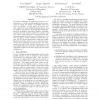677 search results - page 8 / 136 » Distributed data-parallel computing using a high-level progr... |
84
Voted
IPPS
1995
IEEE
15 years 3 months ago
1995
IEEE
For better utilization of computing resources, it is important to consider parallel programming environments in which the number of available processors varies at runtime. In this...
113
click to vote
HPDC
2010
IEEE
15 years 21 days ago
2010
IEEE
Large scale bioinformatics experiments are usually composed by a set of data flows generated by a chain of activities (programs or services) that may be modeled as scientific work...
136
click to vote
ICS
1992
Tsinghua U.
15 years 3 months ago
1992
Tsinghua U.
CODE 2.0 is a graphical parallel programming system that targets the three goals of ease of use, portability, and production of efficient parallel code. Ease of use is provided by...
HPCC
2007
Springer
15 years 5 months ago
2007
Springer
One of the outcomes of DARPA’s HPCS program has been the creation of three new high productivity languages: Chapel, Fortress, and X10. While these languages have introduced impro...
148
click to vote
CONPAR
1994
15 years 3 months ago
1994
Data parallel languages such as Vienna Fortran and HPF can be successfully applied to a wide range of numerical applications. However, many advanced scienti
c and engineering appl...

